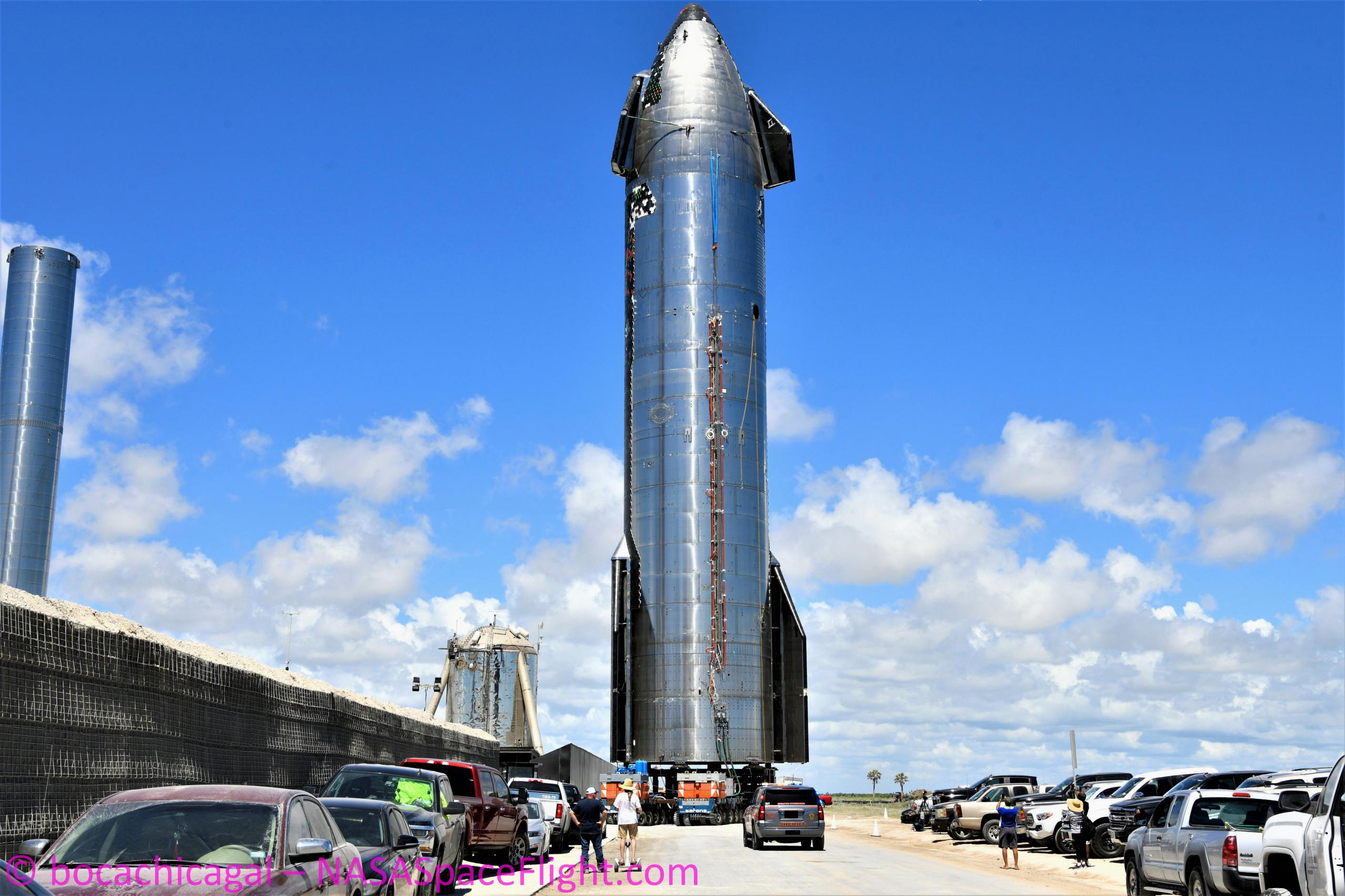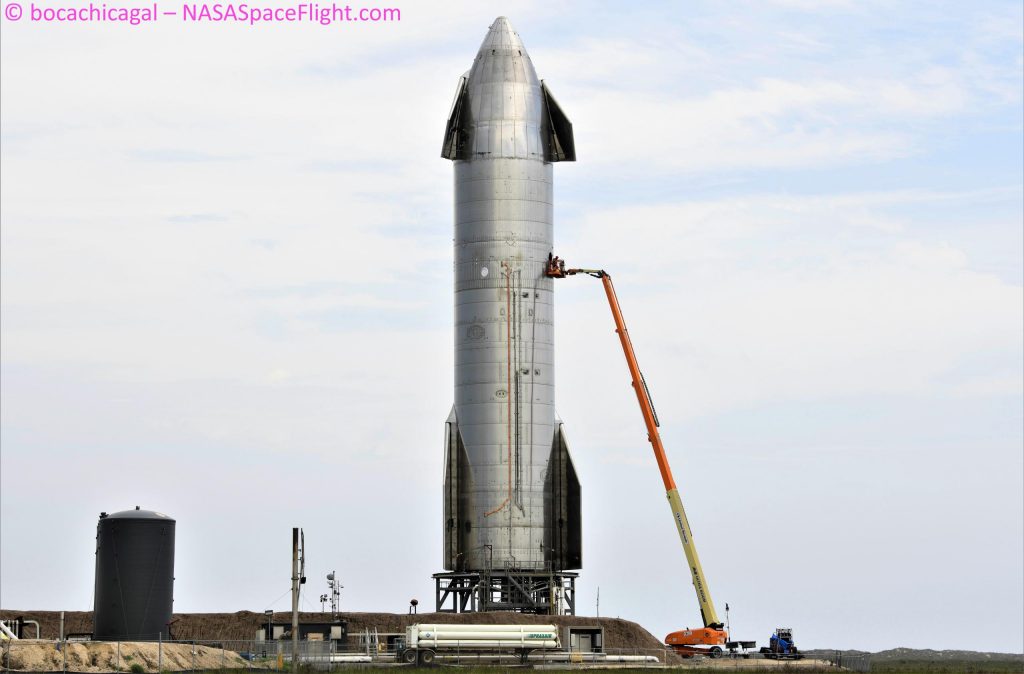

News
SpaceX’s first orbital Starship prototype prepares for proof tests
Several days after SpaceX’s first orbital-class Starship prototype took a second trip to a nearby launch site, the rocket is on its way to one of two suborbital launch mounts.
Once installed on the steel structure, Starship prototype 20 (S20) will finally be ready for – at minimum – two crucial tests: a cryogenic proof and static fire. According to highway closures filed by SpaceX late last week, the first of those tests could apparently begin as early as Thursday, August 19th, potentially setting Starship S20 up to attempt at least one major milestone next week.
On August 13th, SpaceX rolled Starship S20 back to the launch site a week after the rocket was sent to the pad to be briefly stacked on top of a Super Heavy booster – an event that appears to have been something like 50% photo opportunity, 50% test objective. Neither the booster or ship were fully complete at the time and both ultimately required at least another week or two of outfitting and plumbing to be ready for ground testing – let alone flight. Aspirationally, the same pair – Ship 20 and Booster 4 – could be the first to attempt a true orbital Starship launch sometime later this year.
Since its second rollout, Ship 20 has more or less stayed in one place as workers continuously swarmed about the rocket on boom and scissor lifts. Over the last four days, not much has visually changed save for the installation of a handful of heat shield tiles, but the focus clearly centered around the Starship’s ‘raceway’ – a clutch of plumbing and wiring that runs most of the length of the vehicle’s back. Virtually all rockets have them and Starship is no different with a raceway packed with avionics wire runs, plumbing for propellant loading, and smaller lines for pressurization and hydraulics.
While it’s not entirely clear what specific work has been done over the last few days or why it wasn’t done back at the build site, where CEO Elon Musk himself has said such tasks are more easily done, it’s clear that Starship S20 does have a more refined raceway than any ship before it. In recent days, SpaceX has also begun to install structural elements that strongly imply that S20 will be the first Starship to receive a raceway aerocover – not unlike those on Falcon boosters – to protect its external wiring and plumbing in flight.

Regardless, once Starship S20 is installed on one of SpaceX’s two suborbital launch mounts, the vehicle will most likely be prepared for a routine cryogenic proof test. To pass, Starship will need to survive significant thermal and mechanical stress as its tanks are filled with supercool liquid nitrogen and pressurized to at least 6 bar (~90 psi). At this point, a Starship prototype hasn’t failed a cryo proof in more than a year, so the test should be fairly routine.
Curiously, after spending weeks modifying Mount B with a series of hydraulic rams meant to simulate the thrust of Ship 20’s six Raptor engines during its cryo proof(s), SpaceX removed all of that extra hardware just prior to the Starship’s second rollout and now-imminent installation on said mount. Regardless of why, that decision likely means that Starship S20 will move directly to static fire testing once it passes cryo proofing. Given that Ship 20 appears to be on track to be the first Starship prototype of any kind to fire more than three Raptors at a time, that static fire campaign will likely be somewhat cautious, possibly beginning with just 1-3 engines and then moving to four, five, or straight to six.
SpaceX could also throw caution to the wind (not implausible as evidenced by the removal of Pad B’s unused thrust rams) and install and attempt to fire all six Raptors immediately after Ship 20 completes a cryo proof. Based on road closures filed by SpaceX, that testing could begin as early as 5pm to 11pm CDT on Thursday, August 19th. A backup window is also scheduled from 6am to 12pm CDT on August 20th.
News
Tesla begins Robotaxi certification push in Arizona: report
Tesla seems serious about expanding its Robotaxi service to several states in the coming months.

Tesla has initiated discussions with Arizona transportation regulators to certify its driverless Robotaxi service in the state, as per a recent report from Bloomberg News. The move follows Tesla’s launch of its Robotaxi pilot program in Austin, Texas, as well as CEO Elon Musk’s recent comments about the service’s expansion in the Bay Area.
The Arizona Department of Transportation confirmed to Bloomberg that Tesla has reached out to begin the certification process for autonomous ride-sharing operations in the state. While details remain limited, the outreach suggests that Tesla is serious about expanding its driverless Robotaxi service to several territories in the coming months.
The Arizona development comes as Tesla prepares to expand its service area in Austin this weekend, as per CEO Elon Musk in a post on X. Musk also stated that Tesla is targeting the San Francisco Bay Area as its next major market, with a potential launch “in a month or two,” pending regulatory approvals.
Tesla first launched its autonomous ride-hailing program on June 22 in Austin with a small fleet of Model Y vehicles, accompanied by a Tesla employee in the passenger seat to monitor safety. While still classified as a test, Musk has said the program will expand to about 1,000 vehicles in the coming months. Tesla will later upgrade its Robotaxi fleet with the Cyercab, a two-seater that is designed without a steering wheel.
Sightings of Cybercab castings around the Giga Texas complex suggests that Tesla may be ramping the initial trial production of the self-driving two-seater. Tesla, for its part, has noted in the past that volume production of the Cybercab is expected to start sometime next year.
In California, Tesla has already applied for a transportation charter-party carrier permit from the state’s Public Utilities Commission. The company is reportedly taking a phased approach to operating in California, with the Robotaxi service starting with pre-arranged rides for employees in vehicles with safety drivers.
News
Tesla sets November 6 date for 2025 Annual Shareholder Meeting
The automaker announced the date on Thursday in a Form 8-K.

Tesla has scheduled its 2025 annual shareholder meeting for November 6, addressing investor concerns that the company was nearing a legal deadline to hold the event.
The automaker announced the date on Thursday in a Form 8-K submitted to the United States Securities and Exchange Commission (SEC). The company also listed a new proposal submission deadline of July 31 for items to be included in the proxy statement.
Tesla’s announcement followed calls from a group of 27 shareholders, including the leaders of large public pension funds, which urged Tesla’s board to formally set the meeting date, as noted in a report from The Wall Street Journal.
The group noted that under Texas law, where Tesla is now incorporated, companies must hold annual meetings within 13 months of the last one if requested by shareholders. Tesla’s previous annual shareholder meeting was held on June 13, 2024, which placed the July 13 deadline in focus.
Tesla originally stated in its 2024 annual report that it would file its proxy statement by the end of April. However, an amended filing on April 30 indicated that the Board of Directors had not yet finalized a meeting date, at least at the time.
The April filing also confirmed that Tesla’s board had formed a special committee to evaluate certain matters related to CEO Elon Musk’s compensation plan. Musk’s CEO performance award remains at the center of a lengthy legal dispute in Delaware, Tesla’s former state of incorporation.
Due to the aftermath of Musk’s legal dispute about his compensation plan in Delaware, he has not been paid for his work at Tesla for several years. Musk, for his part, has noted that he is more concerned about his voting stake in Tesla than his actual salary.
At last year’s annual meeting, TSLA shareholders voted to reapprove Elon Musk’s compensation plan and ratified Tesla’s decision to relocate its legal domicile from Delaware to Texas.
Elon Musk
Grok coming to Tesla vehicles next week “at the latest:” Elon Musk
Grok’s rollout to Tesla vehicles is expected to begin next week at the latest.

Elon Musk announced on Thursday that Grok, the large language model developed by his startup xAI, will soon be available in Tesla vehicles. Grok’s rollout to Tesla vehicles is expected to begin next week at the latest, further deepening the ties between the two Elon Musk-led companies.
Tesla–xAI synergy
Musk confirmed the news on X shortly after livestreaming the release of Grok 4, xAI’s latest large language model. “Grok is coming to Tesla vehicles very soon. Next week at the latest,” Musk wrote in a post on social media platform X.
During the livestream, Musk and several members of the xAI team highlighted several upgrades to Grok 4’s voice capabilities and performance metrics, positioning the LLM as competitive with top-tier models from OpenAI and Google.
The in-vehicle integration of Grok marks a new chapter in Tesla’s AI development. While Tesla has long relied on in-house systems for autonomous driving and energy optimization, Grok’s integration would introduce conversational AI directly into its vehicles’ user experience. This integration could potentially improve customer interaction inside Tesla vehicles.
xAI and Tesla’s collaborative footprint
Grok’s upcoming rollout to Tesla vehicles adds to a growing business relationship between Tesla and xAI. Earlier this year, Tesla disclosed that it generated $198.3 million in revenue from commercial, consulting, and support agreements with xAI, as noted in a report from Bloomberg News. A large portion of that amount, however, came from the sale of Megapack energy storage systems to the artificial intelligence startup.
In July 2023, Musk polled X users about whether Tesla should invest $5 billion in xAI. While no formal investment has been made so far, 68% of poll participants voted yes, and Musk has since stated that the idea would be discussed with Tesla’s board.
-

 Elon Musk1 week ago
Elon Musk1 week agoTesla investors will be shocked by Jim Cramer’s latest assessment
-

 Elon Musk2 days ago
Elon Musk2 days agoElon Musk confirms Grok 4 launch on July 9 with livestream event
-

 News2 weeks ago
News2 weeks agoTesla Robotaxi’s biggest challenge seems to be this one thing
-

 Elon Musk10 hours ago
Elon Musk10 hours agoxAI launches Grok 4 with new $300/month SuperGrok Heavy subscription
-

 News6 days ago
News6 days agoTesla Model 3 ranks as the safest new car in Europe for 2025, per Euro NCAP tests
-

 Elon Musk2 weeks ago
Elon Musk2 weeks agoA Tesla just delivered itself to a customer autonomously, Elon Musk confirms
-

 Elon Musk2 weeks ago
Elon Musk2 weeks agoTesla’s Omead Afshar, known as Elon Musk’s right-hand man, leaves company: reports
-

 Elon Musk1 week ago
Elon Musk1 week agoxAI’s Memphis data center receives air permit despite community criticism

















